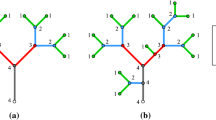Abstract
Questions on the formation of block structures are considered. It is shown that the block structure is characteristic of bodies in a wide range of scales from microscopic to astronomic and from the bodies of nonliving nature to living organisms and communities. A scheme of the mechanism of the probabilistic formation of block structures is suggested. The characteristics general for structures of all scales are revealed. Evidence is presented that the hierarchical pattern of element sizes is characteristic of natural structures in which the ratio of linear sizes of elements neighboring by hierarchy is 2–5, while the characteristic scale coefficient is \(\sqrt N \), where N is the total number of elements of which the system is formed. The block-probabilistic approach ensures knowledge of rare catastrophic events, including earthquakes, market crashes, floods, and industrial catastrophes, or creative events such as the formation of hypercomplex systems similar to organisms and communities. The statistics of rare events follows the power distribution (the distribution with a “heavy tail”) rather than the exponential one and especially the Poisson distribution, the Gaussian distribution, or the distributions with “light tails” close to them. The expression for the factor of increasing the formation probability of the systems, which is of many orders of magnitude even for the simplest systems, is acquired.
Similar content being viewed by others
References
M. S. Sadovskii, L. G. Bolkhovitinov, and V. F. Pisarenko, Deforming of the Geophysical Medium and the Seismic Process (Nauka, Moscow, 1989) [in Russian].
V. A. Babeshko, O. M. Babeshko, and O. V. Evdokimova, Dokl. Akad. Nauk 427(2), 183 (2009).
V. A. Babeshko, O. M. Babeshko, and O. V. Evdokimova, Dokl. Akad. Nauk 427, 480 (2009).
C. Kittel, Introduction to Solid State Physics (Wiley, 1996), 7th edition.
D. Shechtman, http://www.nobelprize.org/nobel_prizes/chemistry/laureates/2011/press.html.
A. L. Mazin, Zh. Vses. Khim. O-va im. D.I. Mendeleeva 25(4), 362 (1980).
A. P. Rudenko, Zh. Vses. Khim. O-va im. D.I. Mendeleeva 25(4), 390 (1980).
A. Yu. Seval’nikov, in Causality and Teleonomism in the Modern Natural-Scientific Paradigm (Nauka, Moscow, 2002) [in Russian].
G. P. Georgiev and Yu. S. Chentsov, Dokl. Akad. Nauk 132(1), 199 (1960).
G. G. Malinetskii and S. P. Kurdyumov, Vestn. Ross. Akad. Nauk 71(3), 210 (2001).
S. E. Shnol’, V. A. Kolombet, T. A. Zenchenko, E. V. Pozharskii, I. M. Zvereva, and A. A. Konradov, Biofizika 43(5), 909 (1998).
F. Kapra, Hidden Bonds (Moscow, Sofia, 2004), p. 336 [in Russian].
A. V. Shubnikov and V. A. Koptsik, Symmetry in Science and Art (Nauka, Moscow, 1972).
Author information
Authors and Affiliations
Corresponding author
Additional information
Original Russian Text © V.I. Ivanov, 2012, published in Doklady Akademii Nauk, 2012, Vol. 443, No. 2, pp. 176–180.
Rights and permissions
About this article
Cite this article
Ivanov, V.I. The probabilistic mechanism of formation of block structures. Dokl. Phys. 57, 125–130 (2012). https://doi.org/10.1134/S1028335812030044
Received:
Published:
Issue Date:
DOI: https://doi.org/10.1134/S1028335812030044




